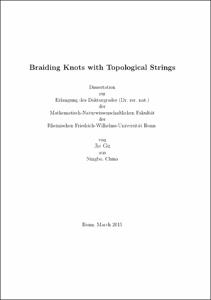Gu, Jie: Braiding Knots with Topological Strings. - Bonn, 2015. - Dissertation, Rheinische Friedrich-Wilhelms-Universität Bonn.
Online-Ausgabe in bonndoc: https://nbn-resolving.org/urn:nbn:de:hbz:5n-41021
Online-Ausgabe in bonndoc: https://nbn-resolving.org/urn:nbn:de:hbz:5n-41021
@phdthesis{handle:20.500.11811/6524,
urn: https://nbn-resolving.org/urn:nbn:de:hbz:5n-41021,
author = {{Jie Gu}},
title = {Braiding Knots with Topological Strings},
school = {Rheinische Friedrich-Wilhelms-Universität Bonn},
year = 2015,
month = aug,
note = {For an arbitrary knot in a three-sphere, the Ooguri-Vafa conjecture associates to it a unique stack of branes in type A topological string on the resolved conifold, and relates the colored HOMFLY invariants of the knot to the free energies on the branes. For torus knots, we use a modified version of the topological recursion developed by Eynard and Orantin to compute the free energies on the branes from the Aganagic-Vafa spectral curves of the branes, and find they are consistent with the known colored HOMFLY knot invariants à la the Ooguri-Vafa conjecture. In addition our modified topological recursion can reproduce the correct closed string free energies, which encode the information of the background geometry. We conjecture the modified topological recursion is applicable for branes associated to hyperbolic knots as well, encouraged by the observation that the modified topological recursion yields the correct planar closed string free energy from the Aganagic-Vafa spectral curves of hyperbolic knots. This has implications for the knot theory concerning distinguishing mutant knots with colored HOMFLY invariants. Furthermore, for hyperbolic knots, we present methods to compute colored HOMFLY invariants in nonsymmetric representations of U(N). The key step in this computation is computing quantum 6j-symbols in the quantum group U_q(sl_N).},
url = {https://hdl.handle.net/20.500.11811/6524}
}
urn: https://nbn-resolving.org/urn:nbn:de:hbz:5n-41021,
author = {{Jie Gu}},
title = {Braiding Knots with Topological Strings},
school = {Rheinische Friedrich-Wilhelms-Universität Bonn},
year = 2015,
month = aug,
note = {For an arbitrary knot in a three-sphere, the Ooguri-Vafa conjecture associates to it a unique stack of branes in type A topological string on the resolved conifold, and relates the colored HOMFLY invariants of the knot to the free energies on the branes. For torus knots, we use a modified version of the topological recursion developed by Eynard and Orantin to compute the free energies on the branes from the Aganagic-Vafa spectral curves of the branes, and find they are consistent with the known colored HOMFLY knot invariants à la the Ooguri-Vafa conjecture. In addition our modified topological recursion can reproduce the correct closed string free energies, which encode the information of the background geometry. We conjecture the modified topological recursion is applicable for branes associated to hyperbolic knots as well, encouraged by the observation that the modified topological recursion yields the correct planar closed string free energy from the Aganagic-Vafa spectral curves of hyperbolic knots. This has implications for the knot theory concerning distinguishing mutant knots with colored HOMFLY invariants. Furthermore, for hyperbolic knots, we present methods to compute colored HOMFLY invariants in nonsymmetric representations of U(N). The key step in this computation is computing quantum 6j-symbols in the quantum group U_q(sl_N).},
url = {https://hdl.handle.net/20.500.11811/6524}
}






